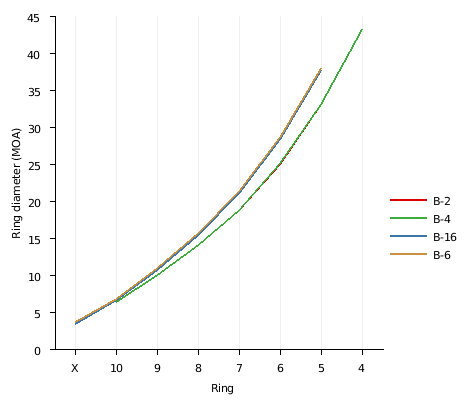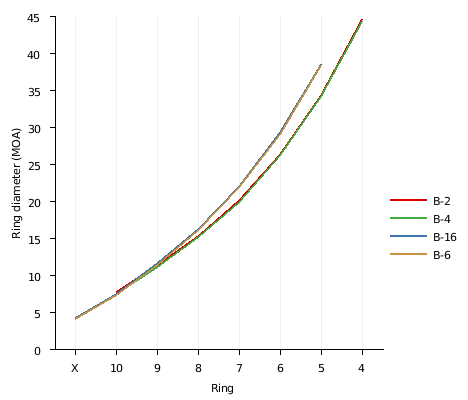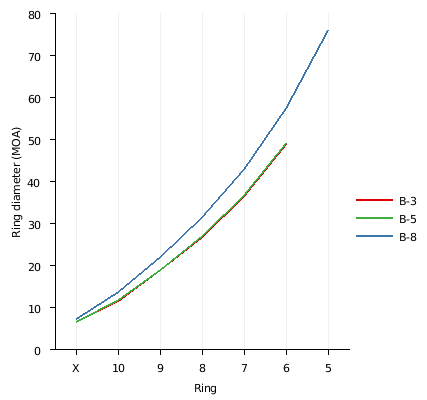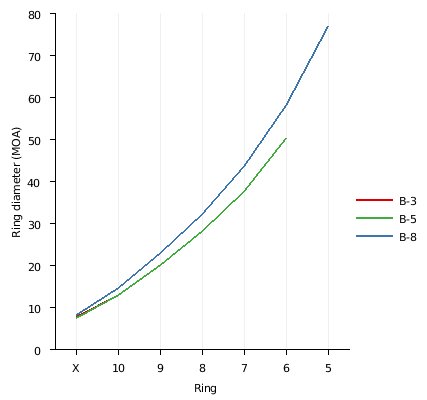A comparison of NRA target dimensions
Introduction
The NRA rulebook for conventional pistol competition defines the sizes of a series of official targets for use at various distances. It has been observed by many that these targets are not interchangable, and that shooting at 50ft is considerably harder than shooting at 25 or 50 yards.
Here, I have compared the dimensions of the various targets to explain why this is the case.
Data
I took my source data from the copy of the NRA rulebook at John Dreyer's "Encyclopedia of Bullseye Pistol":
| Target | Range | X | 10 | 9 | 8 | 7 | 6 | 5 | 4 |
|---|---|---|---|---|---|---|---|---|---|
| B-2 | 50ft | 0.90 | 1.54 | 2.23 | 3.07 | 4.16 | 5.56 | 7.33 | |
| B-4 | 20yds | 1.12 | 1.88 | 2.72 | 3.73 | 5.04 | 6.72 | 8.84 | |
| B-16 | 25yds | 0.67 | 1.51 | 2.60 | 3.82 | 5.32 | 7.22 | 9.66 | |
| B-6 | 50yds | 1.695 | 3.36 | 5.54 | 8.00 | 11.00 | 14.80 | 19.68 | |
| Table 1: Slow fire targets (dimensions in inches) | |||||||||
| Target | Range | X | 10 | 9 | 8 | 7 | 6 | 5 | |
|---|---|---|---|---|---|---|---|---|---|
| B-3 | 50ft | 0.90 | 1.80 | 3.06 | 4.46 | 6.14 | 8.32 | ||
| B-5 | 20yds | 1.12 | 2.25 | 3.76 | 5.44 | 7.46 | 10.08 | ||
| B-8 | 25yds | 1.695 | 3.36 | 5.54 | 8.00 | 11.00 | 14.80 | 19.68 | |
| Table 2: Sustained fire targets (dimensions in inches) | |||||||||
Calculations
To make the dimensions comparable, I will convert the sizes in inches to minutes of arc, using the following formula:
where m is the ring size in MOA, and d is the ring diameter in inches, and r is target range in inches. (Note that this is an approximate method for calculating the angle, but it is a good approximation given the dimensions we are using.)
I compared the ring sizes taken directly from tables 1 and 2, and also with those size adjusted to account for the diameter of a .22 and .45 bullet. This adjustment was simply to add 0.22" or 0.45" to each ring size, to allow for shots just touching the scoring ring.
I also tried comparing the "scoring areas" (i.e. the surface area of each ring), but found that the trends followed those of the diameter comparisons, and so that data is not presented here.
Results
Slow fire targets

Sustained fire
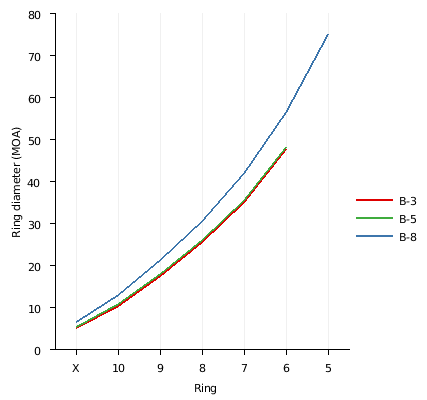
Conclusions
Note that in the calculations and the following observations, no allowance has been made for ammunition being less accurate at longer range. Without a body of data on ammunition accuracy, it would be difficult to make an accurate adjustment. Given the siginifcant differences in ring size, I felt it was reasonable to discount the role of ammunition.
The data bear out the observation that the 25 and 50 yards targets are easier to score on. The B-16 and B-6 slow fire targets are largely interchangable, as are the B-2 and B-4. Likewise, in sustained fire, the B-3 and B-5 targets have comparable dimensions.
Adjusting for caliber brings the B-16/B-6, B-2/B-4, and B-3/B-5 pairs closer together. For slow fire, it also brings the inner ring dimensions closer together, but has little effect on the outer rings, or on the sustained fire targets.
For slow fire, the very wayward shooter might find that the lack of a 4-ring on the B-6 and B-16 could lower scores, but for those of middling ability they offer an advantage. That advantage decreases with group size, since the ring dimensions do converge for the higher scoring rings.
For sustained fire, the B-8 would seem to be always preferable! The addition of the 5-ring, and the consistently larger scoring rings will give most shooters an advantage.
It may seem counter-intuitive to use longer-range targets when beginning shooting, but the above data suggest that shooting at 25 yards may be more rewarding than doing so at 50 feet!
Furthermore, if you want to keep your NRA indoor classification low, shoot B-2 and B-3 targets!
Appendix: Data tables
| Target | X | 10 | 9 | 8 | 7 | 6 | 5 | 4 |
|---|---|---|---|---|---|---|---|---|
| B-2 | 5.16 | 8.82 | 12.78 | 17.59 | 23.84 | 31.86 | 42.00 | |
| B-4 | 5.35 | 8.98 | 12.99 | 17.81 | 24.06 | 32.09 | 42.21 | |
| B-16 | 2.56 | 5.77 | 9.93 | 14.59 | 20.32 | 27.58 | 36.90 | |
| B-6 | 3.24 | 6.42 | 10.58 | 15.28 | 21.01 | 28.27 | 37.59 | |
| Table 3: Slow fire targets (diameters in MOA) | ||||||||
| Target | X | 10 | 9 | 8 | 7 | 6 | 5 |
|---|---|---|---|---|---|---|---|
| B-3 | 5.16 | 10.31 | 17.53 | 25.55 | 35.18 | 47.67 | |
| B-5 | 5.35 | 10.74 | 17.95 | 25.97 | 35.62 | 48.13 | |
| B-8 | 6.47 | 12.83 | 21.16 | 30.56 | 42.02 | 56.53 | 75.17 |
| Table 4: Sustained fire targets (diameters in MOA) | |||||||
| Target | X | 10 | 9 | 8 | 7 | 6 | 5 | 4 |
|---|---|---|---|---|---|---|---|---|
| B-2 | 6.42 | 10.08 | 14.04 | 18.85 | 25.10 | 33.12 | 43.26 | |
| B-4 | 6.40 | 10.03 | 14.04 | 18.86 | 25.11 | 33.14 | 43.26 | |
| B-16 | 3.40 | 6.61 | 10.77 | 15.43 | 21.16 | 28.42 | 37.74 | |
| B-6 | 3.66 | 6.84 | 11.00 | 15.70 | 21.43 | 28.69 | 38.01 | |
| Table 5: Slow fire targets, adjusted for .22 caliber ammunition (diameters in MOA) | ||||||||
| Target | X | 10 | 9 | 8 | 7 | 6 | 5 |
|---|---|---|---|---|---|---|---|
| B-3 | 6.42 | 11.57 | 18.79 | 26.81 | 36.44 | 48.93 | |
| B-5 | 6.40 | 11.79 | 19.00 | 27.02 | 36.67 | 49.18 | |
| B-8 | 7.31 | 13.67 | 22.00 | 31.40 | 42.86 | 57.37 | 76.01 |
| Table 6: Sustained fire targets, adjusted for .22 caliber ammunition (diameters in MOA) | |||||||
| Target | X | 10 | 9 | 8 | 7 | 6 | 5 | 4 |
|---|---|---|---|---|---|---|---|---|
| B-2 | 7.73 | 11.40 | 15.36 | 20.17 | 26.41 | 34.43 | 44.58 | |
| B-4 | 7.50 | 11.12 | 15.14 | 19.96 | 26.21 | 34.23 | 44.36 | |
| B-16 | 4.28 | 7.49 | 11.65 | 16.31 | 22.04 | 29.30 | 38.62 | |
| B-6 | 4.10 | 7.28 | 11.44 | 16.14 | 21.87 | 29.13 | 38.45 | |
| Table 7: Slow fire targets, adjusted for .45 caliber ammunition (diameters in MOA) | ||||||||
| Target | X | 10 | 9 | 8 | 7 | 6 | 5 |
|---|---|---|---|---|---|---|---|
| B-3 | 7.73 | 12.89 | 20.11 | 28.13 | 37.76 | 50.25 | |
| B-5 | 7.50 | 12.89 | 20.10 | 28.12 | 37.77 | 50.28 | |
| B-8 | 8.19 | 14.55 | 22.88 | 32.28 | 43.74 | 58.25 | 76.89 |
| Table 8: Sustained fire targets, adjusted for .45 caliber ammunition (diameters in MOA) | |||||||
